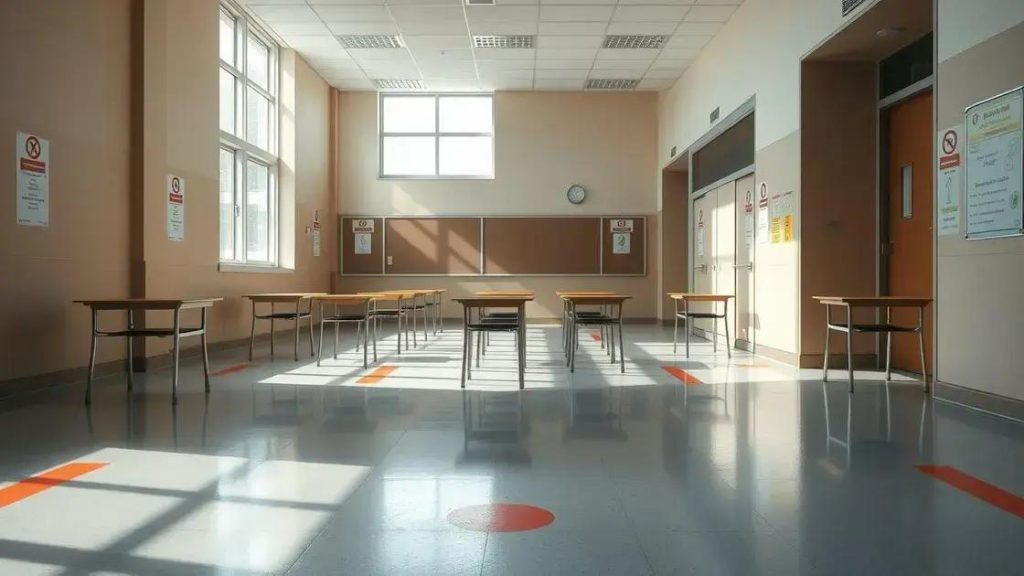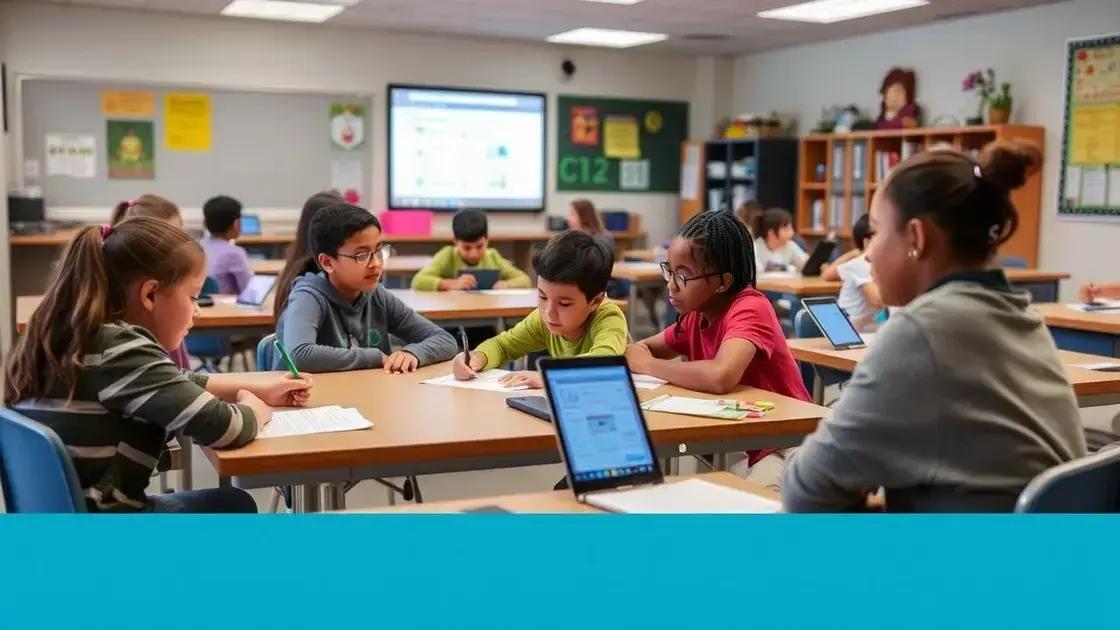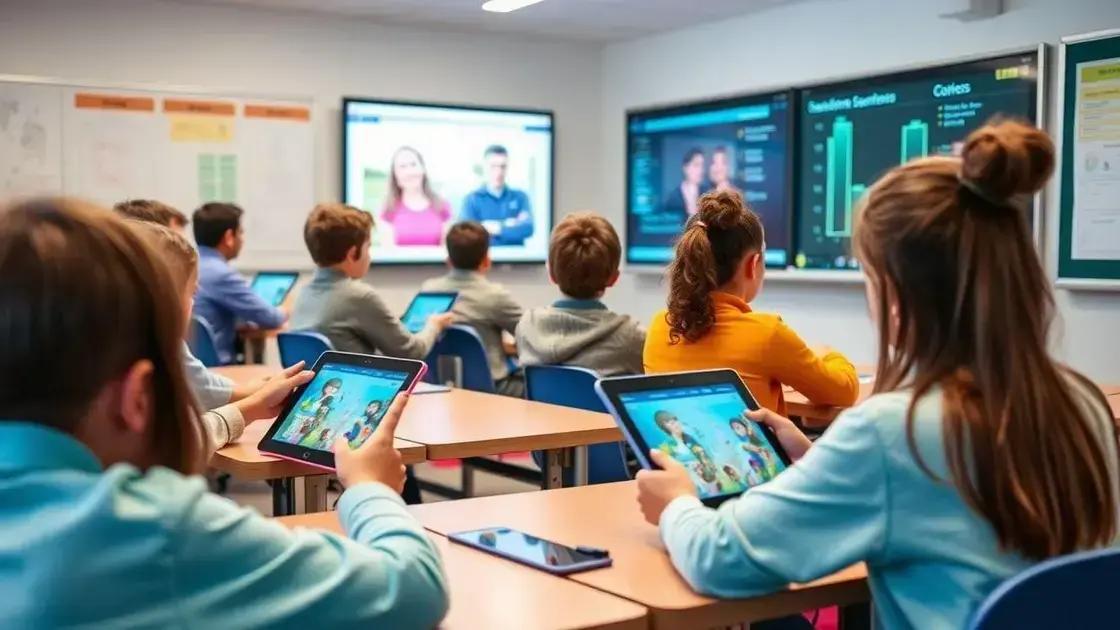School closures impact: understanding the effects

Anúncios
School closures impact academics and mental health, leading to learning gaps, increased anxiety, and disruptions in family and community support, necessitating targeted recovery strategies for students and families.
School closures impact our communities more than we might realize. From academic struggles to emotional well-being, these closures bring various challenges. What does this mean for our children and families?
Anúncios
The immediate effects of school closures
The immediate effects of school closures can be felt across communities. As students are sent home, the rhythm of daily life is disrupted. Classrooms that once buzzed with conversation are now silent. This sudden change not only affects students but also teachers and families.
Educational Disruption
Switching to remote learning creates challenges. Not all students have equal access to technology or a quiet space to learn. Many struggle to find motivation without in-person interaction. Educators face hurdles in adapting their lessons to online formats.
- Access to digital resources varies widely.
- Students may miss crucial hands-on activities.
- Engagement in online classes can be low.
- Teachers require more training for effective remote teaching.
In addition to educational issues, emotional responses arise. Many students feel anxious about their future. They may worry about falling behind in their studies or missing important milestones. The mental health of children is now a significant concern, with reports of increased anxiety and isolation.
Anúncios
Social Implications
The social impact is also notable. School is a place for friendships and social learning. Without these interactions, students may feel isolated. Some families find it difficult to balance work and support their children at home. This can create stress and conflict within households. Parents often report feeling overwhelmed trying to juggle remote work while ensuring their children stay on task.
- Increased stress levels among parents.
- Loss of social skills for children.
- Alienation from peers.
- Possible decline in academic performance.
In conclusion, the immediate effects of school closures are vast and complex. Understanding these impacts helps us address the challenges that lie ahead for our students and families as we seek effective solutions and support.
Long-term academic consequences
The long-term academic consequences of school closures are significant and can affect students for years to come. When classrooms close, valuable instructional time is lost, which can lead to gaps in knowledge and skills.
Learning Gaps
As students transition to online learning, many face challenges that can hinder progress. Some may not keep pace with their peers, while others might find it hard to grasp complex subjects without direct support. These learning gaps can widen over time, impacting students’ overall academic performance.
- Students may struggle with foundational skills.
- Advanced concepts become even more difficult to understand.
- Standardized test performances may decline.
- Continuous interruptions can lead to disengagement from learning.
Furthermore, the impact on younger students can be particularly pronounced. For example, early literacy and numeracy skills develop during formative years. Missing out on essential classroom experiences can lead to long-lasting difficulties.
Impact on Graduating Students
Older students also feel the effects. Those preparing for graduation may face obstacles in meeting requirements. College readiness diminishes if essential learning experiences are missed. Many students found themselves unprepared for the challenges of higher education when schools switched to remote formats.
- Transitioning to college-level work can be harder.
- Students may lack the necessary study skills.
- Social skills that aid in group projects may lag.
- Increased anxiety about academic performance is common.
Throughout this period of uncertainty, educators strive to adapt and provide support, yet the challenges remain. Understanding these long-term academic consequences is crucial for developing strategies to assist affected students in overcoming their struggles and successfully navigating their educational journeys.
Mental health challenges for students

Mental health challenges for students have become a growing concern during and after school closures. As educational settings shifted abruptly, many students faced increased anxiety and stress. Social isolation and uncertainty about the future contributed to feelings of loneliness and fear.
Increased Anxiety Levels
Many students who thrived in structured environments suddenly found themselves struggling. The lack of daily routines and personal connections can heighten anxiety. They may worry about academic performance, missing out on social experiences, or changes in family dynamics.
- Feeling disconnected from peers.
- Struggling to adapt to online learning.
- Increased stress due to isolation.
- Concerns about family health and safety.
Students often find it challenging to express these feelings. Many may not know how to seek help or might feel embarrassed to do so. However, recognizing these emotional challenges is a crucial step toward healing.
Effects on Academic Performance
The mental health of students can significantly impact their academic performance. When students struggle emotionally, their ability to focus and perform well in school decreases. They may have difficulty completing assignments or participating in class activities, further exacerbating feelings of inadequacy.
- Lower engagement in learning activities.
- Declining grades due to lack of motivation.
- Increased absences from online classes.
- Poor coping strategies may lead to disruptive behavior.
It is essential for schools to foster a supportive environment where students can discuss their feelings without stigma. By prioritizing mental well-being and providing resources, educators can help students navigate these challenging times.
Impact on families and communities
The impact on families and communities due to school closures reaches far beyond the classroom. As schools shut down, families find themselves navigating new challenges, which can strain their resources and dynamics.
Increased Family Stress
With children at home, parents often experience heightened stress levels. Juggling work responsibilities while supporting their children’s education can be overwhelming. Many families face financial uncertainties, especially those reliant on school-based services.
- Some parents lose their jobs or work hours.
- Access to meals and essential services is disrupted.
- Increased responsibility for children’s education leads to burnout.
- Family relationships may be tested under pressure.
This increase in stress can lead to feelings of isolation and helplessness for both parents and children. Open communication within families becomes crucial to manage these obstacles effectively.
Community Connections
Beyond the household, entire communities are affected by school closures. Schools often serve as community hubs, providing not just education, but also resources, social services, and a sense of belonging. When schools close, these vital connections are severed.
- Local events and programs that foster community engagement are canceled.
- Support networks that rely on schools may diminish.
- Volunteer opportunities for families are reduced.
- Communities may struggle with the increased demand for social services.
Additionally, children miss out on important social interactions with peers, which play a key role in developing social skills. Communities can mitigate some of these challenges by offering virtual support and resources, but the loss of physical interaction is still felt deeply.
Strategies for recovery and support
Strategies for recovery and support are essential for addressing the impacts of school closures. As schools and communities look to rebuild, focusing on the well-being of students and families is vital. Effective strategies can help facilitate learning and emotional healing.
Academic Support Programs
Implementing academic support programs is crucial for helping students catch up. Schools can provide additional tutoring sessions and resources to bridge learning gaps. These programs should be accessible to all students.
- Offer after-school tutoring for struggling learners.
- Introduce online resources and learning platforms.
- Encourage parental involvement in homework and projects.
- Create summer learning opportunities to prevent regression.
When students receive targeted help, it can lead to increased confidence and improved academic performance.
Mental Health Resources
The importance of mental health resources cannot be overstated. Schools should prioritize access to counseling and support services. This can help students navigate their feelings and develop effective coping strategies.
- Provide telehealth services for easy access to counselors.
- Organize workshops about stress management techniques.
- Foster peer support groups where students can share experiences.
- Include mental health education in the curriculum to raise awareness.
By addressing mental health openly, schools can create a supportive environment that fosters resilience among students.
Community Involvement
Community involvement is key to rebuilding after disruptions. Schools can partner with local organizations to provide additional resources and support to families. Engaging the community will create a network of assistance.
- Collaborate with local businesses for internship opportunities.
- Organize community service events to connect families.
- Promote food programs that address food insecurity.
- Encourage mentorship programs between older and younger students.
When communities come together to support education, the impact can be significant, leading to stronger relationships and improved outcomes for everyone involved.
FAQ – Questions about the impact of school closures on students and communities
What are the immediate effects of school closures on students?
School closures disrupt learning, leading to academic gaps and increased anxiety among students due to isolation and uncertainty.
How can families cope with the stress of school closures?
Families can cope by maintaining open communication, establishing routines, and seeking support from local resources and communities.
What support strategies can schools implement for recovery?
Schools can provide academic support, mental health resources, and involve the community to aid recovery efforts and foster resilience.
Why is mental health support important for students?
Mental health support is crucial as it helps students manage anxiety, stress, and emotional challenges, enabling them to focus better on their education.





